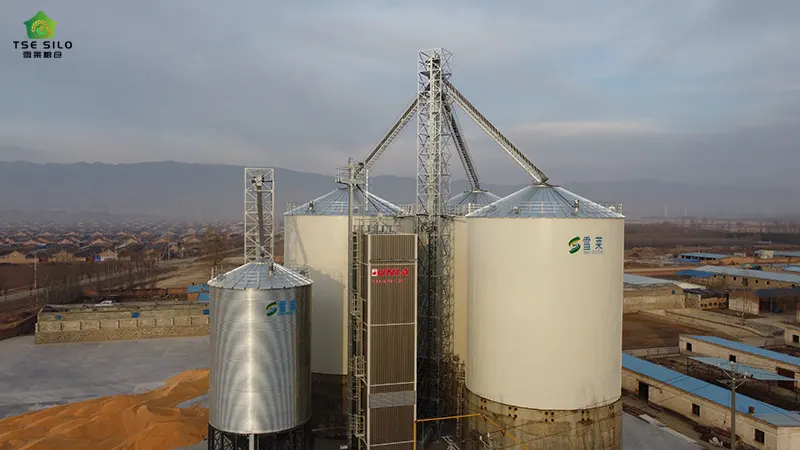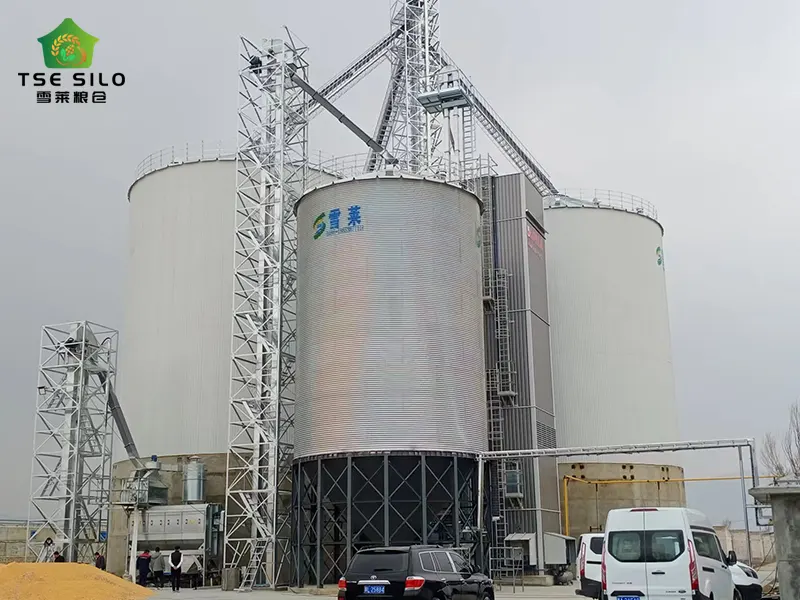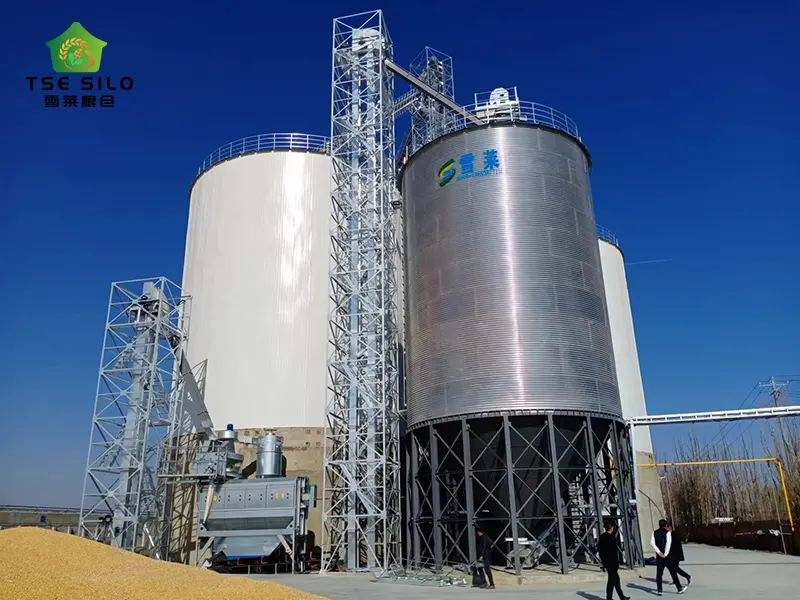In the construction of steel silos, the most popular ones are prefabricated steel silos. Many people think that prefabricated steel silos only need to be assembled at the construction site. In fact, this is very wrong. In the installation process of the entire steel silo, welding work is still a relatively large and important part. In the group, we will explain to you the grain steel silo welding operation specifications and precautions.
I. Preparation before welding
We are not unfamiliar with prefabricated steel silos. It is deeply loved by the grain storage industry mainly because of its large capacity, short construction period, flexible configuration and other advantages. Many people think that welding is not required when building prefabricated steel silos. In fact, this is very wrong. In the installation process of the entire prefabricated steel silo, welding work still accounts for a large proportion. Today we will explain to you the six preparation measures before the start of prefabricated steel silo welding work.
1. Drawing and process review:
Carefully read the design drawings and technical requirements, and clarify the weld location, type (butt joint, corner joint, overlap), size, grade (such as important welds, general welds) and non-destructive testing requirements.
Develop or review the welding procedure specification (WPS) to ensure that it is suitable for the materials used (steel plate grade, thickness) and welding methods.


2. Material inspection:
- Steel plate: Check the steel plate material certificate to verify whether the grade and specification meet the requirements. Check the surface quality of the steel plate and remove oil, rust, scale, moisture and other impurities that affect the welding quality. For high-strength steel or steel plates with special requirements, pay attention to the preheating temperature and interlayer temperature control requirements.
- Welding materials: Check the model, specification, batch number and certificate of welding rods, welding wires and fluxes to ensure that they are consistent with the WPS regulations and meet the requirements of the parent material. Welding rods are dried and insulated as required, and fluxes are dried as required.
3. Groove processing and cleaning:
- Process the groove (such as V-type, X-type, U-type, etc.) according to the drawings or WPS requirements to ensure that the groove angle, blunt edge size and gap are uniform.
- Both sides of the groove and the surrounding area (usually within 20-30mm) must be thoroughly cleaned to reveal the metallic luster. Grinding with a grinding wheel, cleaning with a wire brush, etc. can be used.
4. Assembly and spot welding:
- Accurately assemble the steel plates in place, and use fixtures and clamps to ensure that the misalignment is within the allowable range (usually ≤10% of the plate thickness, and ≤3mm).
- Spot welding (positioning welding) should be performed by qualified welders using the same welding materials as the formal weld. The length, spacing and thickness of the spot welding should meet the requirements of the specifications, and ensure good fusion to avoid defects such as cracks and slag inclusions. The spot welding position should be convenient for subsequent welding operations and avoid stress concentration areas.
5. Inspection of welding machines and tooling:
- Check whether the welding equipment (welding machine, wire feeder, welding gun/welding handle, cable, etc.) is in good condition and whether the instrument indication is accurate.
- Prepare necessary auxiliary tools (such as slag hammer, wire brush, angle grinder, thermometer, etc.) and safety protection supplies (welding helmet, gloves, protective clothing, ventilation equipment, etc.).
6. Environmental control:
- Ensure that the welding environment meets the requirements: if the ambient temperature is too low (usually below 0°C), preheating or protective measures need to be taken; if the relative humidity is too high (>90%) or it is rainy or windy (wind speed>2m/s), a wind and rain shelter needs to be set up; ensure that the working area has good ventilation, especially when welding in the warehouse, to prevent the accumulation of harmful gases.
II. Welding process control
For the installation process of grain steel silos, welding operation is a common and demanding job. When we are working, we must ensure the quality of welding and take care of the surrounding environment. Do not cause harm and danger to the surrounding environment due to welding operations.
1. Preheating and interlayer temperature control:
- Preheat the parts that need to be preheated (such as thick plates, high-strength steel, and low ambient temperature) strictly in accordance with WPS requirements. The preheating temperature is uniform, and the range should cover at least 3 times the plate thickness on both sides of the weld (or as required by the specification), and use a thermometer for monitoring.
- In the process of multi-layer and multi-pass welding, strictly control the interlayer temperature within the range specified by WPS (usually with upper and lower limits). Too high temperature may lead to coarse grains and reduced performance; too low temperature may increase the risk of cold cracking.
2. Execution of welding parameters:
- Welding is strictly carried out in accordance with the parameters set by WPS: welding current, arc voltage, welding speed, wire/electrode diameter, shielding gas flow (such as MIG/MAG), weld bead arrangement sequence, etc. It shall not be changed at will.
3. Welding operation technology:
- Welder qualification: Welders must hold valid qualification certificates for corresponding projects (such as plate butt, fillet weld, submerged arc welding, gas shielded welding, etc.).
- Arc starting and arc ending: Use correct arc starting (such as scratching method, direct hitting method) and arc ending techniques to avoid arc starting in non-welding areas of parent materials. When ending the arc, the arc pit should be filled to prevent arc pit cracks.Wire feeding method: Select the appropriate wire feeding method (straight line, crescent, serrated, etc.) according to the welding position (flat, horizontal, vertical, vertical), groove form and welding method to ensure good fusion and beautiful weld bead formation, and avoid defects such as unfusion, undercut, slag inclusion, etc.
- Multi-layer multi-pass welding: For thick plate welds, multi-layer multi-pass welding is used. After each layer of welding, the welding slag and spatter must be thoroughly removed (root cleaning), and the next layer of welding can be carried out after careful inspection without defects. The overlap between passes is reasonable.
- Welding sequence: Formulate a reasonable welding sequence (such as symmetrical welding, segmented back welding, skip welding, etc.) to minimize welding stress and deformation. Especially for the vertical seam and circumferential seam welding of large steel silos, the sequence is particularly important.
- Deformation monitoring: Monitor the deformation of the silo plate or structure at any time during the welding process, and take anti-deformation or corrective measures when necessary.
4. Weld seam identification:
- According to the quality system requirements, welders should stamp their welder stamps or other traceable identification near the welds.


III. Post-weld processing and inspection
For grain steel silo, the welding work has very high requirements in terms of working time and technical standards throughout the construction process. Whether it is the understanding of the drawings or the requirements for welding quality, the entire project is tracked by professional quality inspection personnel throughout the process.
1. Post-weld cleaning:
- Remove welding slag and spatter from the weld and nearby areas.
2. Weld appearance inspection:
- Self-inspection: The welder should conduct a self-inspection immediately after welding.
- Special inspection: The quality inspector shall conduct a 100% inspection of the weld appearance. The inspection contents include: whether the weld formation (uniform and smooth transition), excess height, width, and weld leg size meet the requirements; whether there are surface defects (such as cracks, pores, slag inclusions, undercuts, lack of fusion, arc crater cracks, weld nodules, spatter, etc.).
3. Non-destructive testing:
- According to the drawings, specifications and WPS requirements, non-destructive testing (NDT) is performed on welds of specified proportions or locations.
- Common methods: Ultrasonic testing (UT) (sensitive to internal defects, commonly used for butt welds), radiographic testing (RT) (intuitive display of internal defects, high cost), magnetic particle testing (MT) (detection of surface and near-surface defects, such as the surface of fillet welds), penetrant testing (PT) (detection of surface opening defects).
- The inspection ratio and qualified level must comply with the requirements of the design and relevant standards (such as GB, AWS, EN, etc.). Unqualified welds must be repaired.
4. Post-weld heat treatment:
- For thick plates or special material welds that require the elimination of welding residual stress, post-weld heat treatment (such as stress relief annealing) must be carried out as required.
5. Rework:
- For defects exceeding the standard found by appearance inspection or non-destructive testing, rework must be carried out.
- A rework process plan must be formulated for rework, and it must be performed by experienced and qualified welders. Before rework, defects must be thoroughly removed, and MT/PT must be performed to confirm that the defects have been removed if necessary. After rework, appearance inspection and non-destructive testing must be carried out again according to the original requirements. The number of reworks on the same part is usually strictly limited (such as no more than 2 times).
IV. Safety precautions
- 1. Fire and explosion prevention: Clean up flammable and explosive items in the welding area and equip them with sufficient fire-fighting equipment. Be careful of splashing and heat conduction igniting surrounding items.
- 2. Anti-electric shock: Check that the welding machine is well grounded and the cable insulation is not damaged. Wear dry insulating gloves and shoes. Avoid contact with live objects. Turn off the power or wear insulating gloves when changing welding rods or touching welding handles.
- 3. Arc radiation protection: Use a welding mask that meets the standards (automatic dimming or lenses with appropriate blackness) correctly, wear protective clothing, gloves, and sleeves to prevent skin exposure. Set up a light shield to protect others.
- 4. Protect against harmful gases and smoke: Especially when welding in confined spaces (such as warehouses), forced ventilation (such as using exhaust fans and blowers) is required. Wear a suitable dust and gas mask or mask.
- 5. Anti-scalding: Welding spatter, high-temperature weldments, welding rod heads, etc. are prone to burns. Pay attention to protection and do not touch the workpiece that has just been welded with your bare hands.
- 6. Anti-falling/object impact: Safety belts must be worn for high-altitude operations, and tools, welding rod heads, etc. must be placed securely to prevent falling and injuring people. Pay attention to hoisting safety.
- 7. Noise prevention: Earplugs or earmuffs must be worn when working in a high-noise environment for a long time.
Summary
Steel silo welding is a systematic project involving materials, processes, equipment, personnel, inspection, safety and other aspects.
The key lies in:
- Strict pre-welding preparation (materials, grooves, assembly, environment).
- Accurate process control (preheating, parameters, sequence, operating technology).
- Perfect post-weld inspection (appearance, non-destructive testing).
- Effective control of unqualified products (repair).
- Safety awareness throughout.
Only by strictly abiding by the welding process regulations and relevant standards and specifications, carefully operated by qualified welders, and implementing effective quality control and safety measures, can the quality of steel silo welding joints and the safety and reliability of the overall structure be ensured. I hope the above description can be of some help to you in the future when you carry out steel silo construction.
Written by
Shandong Shelley Grain Steel Silo Co., Ltd
Editor Jin
www.grainstoragesilos.com
WhatsApp : +86-18653877118
Email : shelley@cnshelley.com






